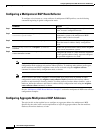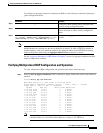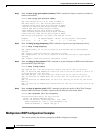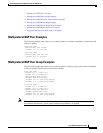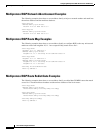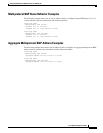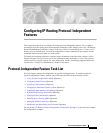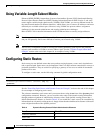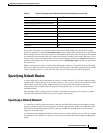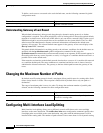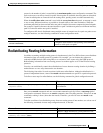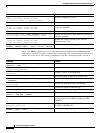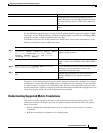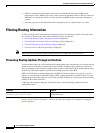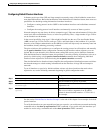
Configuring IP Routing Protocol-Independent Features
Using Variable-Length Subnet Masks
IPC-364
Cisco IOS IP Configuration Guide
Using Variable-Length Subnet Masks
Enhanced IGRP (EIGRP), Intermediate System-to-Intermediate System (IS-IS) Interdomain Routing
Protocol, Open Shortest Path First (OSPF), Routing Information Protocol (RIP) Version 2, and static
routes support variable-length subnet masks (VLSMs). With VLSMs, you can use different masks for
the same network number on different interfaces, which allows you to conserve IP addresses and more
efficiently use available address space. However, using VLSMs also presents address assignment
challenges for the network administrator and ongoing administrative challenges.
Refer to RFC 1219 for detailed information about VLSMs and how to correctly assign addresses.
Note Consider your decision to use VLSMs carefully. You can easily make mistakes in address assignments
and you will generally find it more difficult to monitor your network using VLSMs.
Note The best way to implement VLSMs is to keep your existing numbering plan in place and gradually
migrate some networks to VLSMs to recover address space. See the “Variable-Length Subnet Mask
Example” section at the end of this chapter for an example of using VLSMs.
Configuring Static Routes
Static routes are user-defined routes that cause packets moving between a source and a destination to
take a specified path. Static routes can be important if the Cisco IOS software cannot build a route to a
particular destination. They are useful for specifying a gateway of last resort to which all unroutable
packets will be sent.
To configure a static route, use the following command in global configuration mode:
See the “Overriding Static Routes with Dynamic Protocols Example” section at the end of this chapter
for an example of configuring static routes.
The software remembers static routes until you remove them (using the no form of the ip route global
configuration command). However, you can override static routes with dynamic routing information
through prudent assignment of administrative distance values. Each dynamic routing protocol has a
default administrative distance, as listed in Table 9. If you would like a static route to be overridden by
information from a dynamic routing protocol, simply ensure that the administrative distance of the static
route is higher than that of the dynamic protocol.
Command Purpose
Router(config)# ip route prefix mask {ip-address |
interface-type interface-number} [distance] [tag tag]
[permanent]
Establishes a static route.
Table 9 Dynamic Routing Protocol Default Administrative Distances
Route Source Default Distance
Connected interface 0
Static route 1



